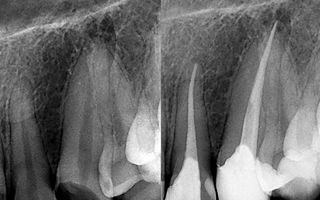Endodontics (root canal)
Looking after the health of the soft tissues inside your teeth.

With Richmond Fine Dentistry root canal treatments, Melbourne has a dentist it can trust for professional and high quality root canal treatments.
What is root canal treatment?
There is a lot of apprehension that surrounds root canal treatment, as it is perceived as a painful and intense procedure. The objective of root canal treatment is the relief of pain caused through an infection, abscess or damage to the tooth pulp, and to save your natural tooth.
Infection of the tooth pulp
Your tooth is divided into two sections. The crown consists of the enamel above the gumline, and below the gumline is the root, comprising the pulp. The pulp is sometimes called the tooth nerve and is what lies inside the tooth. It contains nerves, blood vessels and connective tissues. A tooth may have as few as one or as many as four root canals.
Part 1 of a Root Canal Treatment
Part 2 of a Root Canal Treatment
Not so long ago an infected pulp meant there was no alternative other than removal of the tooth, which can result in adjacent teeth moving out of alignment. Saving and restoring your natural tooth is often the ideal solution, not only for the appearance of your smile but also for maintaining your oral health. Retaining your natural tooth and its root is the easiest and most economical way of filling a space compared with a bridge or a dental implant.
Act quickly to save your tooth
The longer you delay your root canal treatments the more severe the pain and extensive the infection can become, this can cause irreversible bone and tissue damage and there may be no alternative other than to extract a tooth that may have been able to be saved. The sooner root canal treatments are performed the easier and more successful the procedure.
An infected tooth will not always cause pain initially so you may be unaware of a problem. As the infection develops, so does the severity of the pain.

Signs you may need root canal treatment
- A tooth with severe sensitivity when you bite down or push it with your tongue
- Sensitivity to hot and cold which lasts for longer than a few seconds
- Swelling of your face and gum near the infected tooth
- A tooth with deep decay
- A fractured tooth
- Breakdown or loss of a filling
- An injury to the tooth caused by an accident or trauma.
Signs of Tooth Decay -->
--> Detection of Tooth Decay
New dental techniques and the development of fine instruments, enables root canal treatments to be completed more efficiently and comfortably than ever before in as few as 2 appointments.
Root canal procedure
Prior to the commencement of any treatment, we will conduct a comprehensive assessment examination to determine the most suitable treatment option for you; this will also include radiographs. From this we will be able to develop a tailored treatment program.
Your comfort is our priority; a local anaesthetic is administered and will numb the entire area so you are completely relaxed. A latex sheet called a dam is placed around the tooth receiving treatment to keep the area sterile, dry and protected, it will also prevent the spread of any infection.
If treatment is required as a result of tooth decay, it is firstly removed before a chamber to access the tooth roots is carefully made in the top of your tooth. The infected pulp is then removed, the root chambers are cleaned sterilised, re-shaped and smoothed. To fill your root canals, m iniature cone-shaped rubber seals called ‘gutta percha’ are sealed in the canals with a special root canal sealant.

After root canal treatment
Often following root canal treatment your tooth will be brittle as a portion of the natural tooth structure needs to be removed to enable access to the tooth roots, therefore a crown will need to be placed to restore its strength and appearance. Should an extensive amount of your tooth need to be removed due to the effects of decay, a titanium post, or glass fibre post can be placed to provide extra support.
You may experience some post-treatment discomfort for several days following your procedure. A cold compress and over-the-counter pain relief medication can alleviate any discomfort. We will schedule a follow-up exam to monitor the healing of your tooth.
Root-filled teeth can discolour, so at the conclusion of treatment an internal bleaching agent can be applied to restore your tooth’s natural colour and appearance. Application of this whitening treatment may require several appointments. Internal tooth whitening of front teeth is usually done when most of the tooth’s natural structure is remaining.
Frequently asked questions
A root canal treatment in Australia depends on a number of factors, such as how many canals the tooth has (one canal makes for a simpler and faster procedure than a tooth with four canals), and whether you need additional appointments or sedation.
You may also need to factor in the cost of getting a dental crown, as this is an important follow-up to most root canals and can add an additional cost.
If you need financial assistance for your treatment, we offer an exclusive interest-free payment plan called SmileFund. With SmileFund, you can undergo your dental treatment and pay it off over time.
Yes, absolutely. Anyone who knows the pain of a soft tissue infection or the nerve dying inside the tooth knows just how worthwhile a root canal is. Not only does this treatment rid you of what can be severe dental pain, it also prevents the infection spreading further, and helps to preserve your natural tooth and avoid further dental treatments that you would need to replace it.
A dentist and an Endodontist have the same basic training and skills, but an Endodontist specialises in treatment of the soft tissues in the teeth. That’s why an Endodontist will often perform complicated root canal procedures or other treatments that involve the soft tissue in the tooth.
The most common procedure that an Endodontist performs is a root canal, but they can also fix cracked teeth, place dental implants, do root canal re-treatments, root end surgeries, and anything else relating to the soft tissue inside your tooth.
Sometimes, your dentist may not have the additional training or knowledge they would need in order to perform a treatment. This is most often the case for complicated root canal treatments, but your dentist may also send you to an Endodontist for other procedures, such as fixing an old root canal or placing a dental implant.






